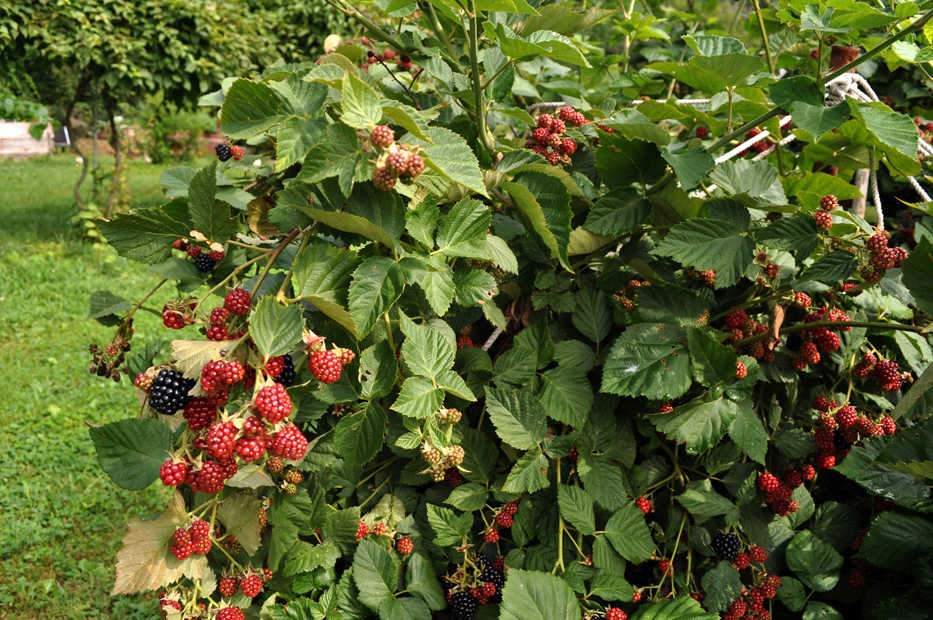For the past couple of weeks, I’ve been picking and eating what are arguably the best fruits I have ever tasted (a belief I often hold when a particular fruit is ripe). They are blackberries, but not just any blackberries: Because my plant is a cultivated variety and grown under garden conditions, its berries are especially swollen with sweet, aromatic juice.
Wild blackberries grow abundantly throughout much of the world, but these cultivated ones have the edge in size, juice and flavor.
Most important is that each blackberry hangs on the plant just beyond its showy, glossy black stage, until it is dead ripe. At that point, blackberries are dull black, as if sullenly crying out to be plucked, an impression reinforced by their readiness, at the slightest suggestion, to part from their stalks and stain the fingertips.
To withstand the rigors of shipping, commercial blackberries are picked when black but still firm — and tart. Fruit allowed to develop full flavor on the plant cannot tolerate being carried more than about 3 feet, the distance from hand to mouth.
Growing blackberries can be intimidating because of their thorns. Most blackberry plants are thoroughly armed, even on their leaves, with ferocious thorns that grab, stab and hold you.
Many gardeners are willing to put up with the pain because the fruit is so delicious.
Not I. I grow thorn-less varieties of blackberries, horticultural wonders with pretty much all the qualities of their thorny relatives except the thorns. Some good varieties of thorn-less blackberries are Chester and Doyle, the latter not cold-hardy in the coldest regions, but making canes long enough to be laid on the ground and insulated under a blanket of leaves from January to March. Other good varieties include Triple Crown and Hull, which are erect varieties like Chester, and Thornless Boysen and Marion (thorny), both with trailing canes.
Whether your blackberries are thorn-less or thorny, growing them well requires choosing a good site and pruning the plants annually.
As for site, don’t be fooled by blackberries that grow wild along the edges of woods. Blackberries tolerate some shade but, like blueberries and pawpaws, fruit and grow better in full sun. The best soils will be well-drained and blanketed with an organic mulch of leaves or straw to keep them consistently moist and rich in humus.
There’s no art to pruning blackberries, just a straightforward recipe: Remember that individual blackberry canes are biennial, fruiting and dying after their second season, and fruits are borne on side shoots.
Let’s make believe it’s late winter: Step 1 in pruning is to cut away at ground level any cane that fruited the previous summer. You’ll recognize these canes by the remains of fruit stalks still clinging to them.
Step 2 is to remove — again, to ground level — some of the new canes, which will fruit this summer. Too many canes results in crowding, so limit each clump of plants to about six new canes annually.
That’s all that’s needed for the long, willowy canes of trailing blackberries. With a single-wire trellis you can lift the remaining canes and tie them to the wire, while letting new canes, which will fruit the following season, trail along the ground.
For so-called erect varieties, the third step in pruning is to shorten side shoots on remaining canes to about 18 inches each. This limits the number of fruits they can bear, but forces them to pump more sweetness and size into those that remain.
Now let’s jump back into summer for the fourth step in pruning erect varieties: Throughout summer, whenever a young cane reaches a height of 3 to 5 feet, pinch out its growing tip. This pinch stimulates the growth of side branches on which will hang next year’s luscious berries.
Year after year, all this pruning keeps any blackberry planting productive, healthy and easy to harvest — and all the more fun if the plants are thorn-less.

